US Dollar Exchange Rates of 10th
March 2014
China Yuan 6.1389
Report from China
Prices for new homes continue to rise
In February this year in the 70 medium and large-sized
cities surveyed prices of newly built homes declined in 6
cities, remained the same in 2 cities and increased in the
balance. The maximum month-on-month increase was 1.2
percent.
Compared with prices in the same month of last year,
prices of newly constructed residential buildings increased
in 69 cities. In January this year the highest year-on-year
change was an increase of almost 21 percent.
See:
http://www.stats.gov.cn/english/PressRelease/201402/t201
40225_515933.html
Prices of second-hand homes were also surveyed and
found to have fallen in 13 cities, remained stable in 9 cities
and increased in 48 cities.
China's PMI at 50.2 in February
China‟s National Bureau of Statistics of China has issued a
press release on the manufacturing PMI.
See:
http://www.stats.gov.cn/english/PressRelease/201403/t201
40303_518369.html
In February, China's manufacturing purchasing managers
index (PMI) was 50.2, down by 0.3 points month-onmonth
but still above the negative threshold, indicating a
healthy manufacturing sector but one where February
production declined because of the "Spring Festival"
holidays.
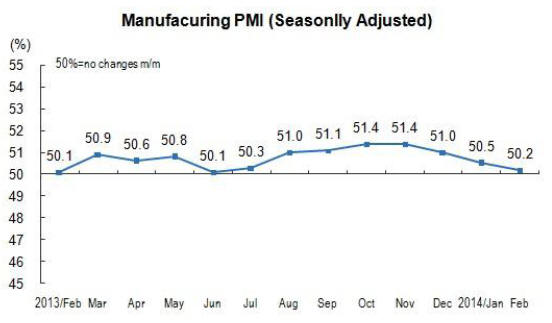
In terms of size of enterprises, the PMI of large-sized
enterprises was 50.7, down 0.7 points month-on-month but
still in positive territory.
The PMI for medium-sized enterprises was 49.4, down by
0.1 point month-on-month, it has been below the negative
threshold for 3 consecutive months.
The PMI for small-sized enterprises was 48.9, up by 1.8
points month-on-month but still positioned below the
threshold.
In February, amongst the five sub-indices comprising the
PMI, one sub-index increased, while the other four
declined. The production index was 52.6, down 0.4 points
month-on-month. The New Orders index was 50.5, down
by 0.4 points month-on-month.
The February survey results showed that the new export
orders index and import index, reflecting foreign trade of
manufactured goods were 48.2 and 46.5 respectively down
1.1 and 1.7 points month-on-month. Both indexes have
been below the 50 threshold for 3 consecutive months.
Timber price indices
The following illustration of price trends are based on data
released by the Ministry of Commerce and the China
Timber and Wood Products Distribution Association and
published in the Chinese journal "China Timber and Wood
Products".
For full details see:
http://www.cnwood.org/default.htm and
http://ltfzs.mofcom.gov.cn/article/buwg/redht/201305/201
30500128380.shtml.
The price indices provided are based on the CIF price so
caution is advised when assessing the trends.
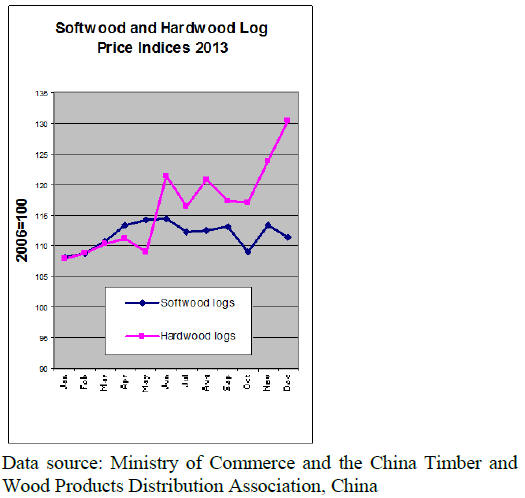 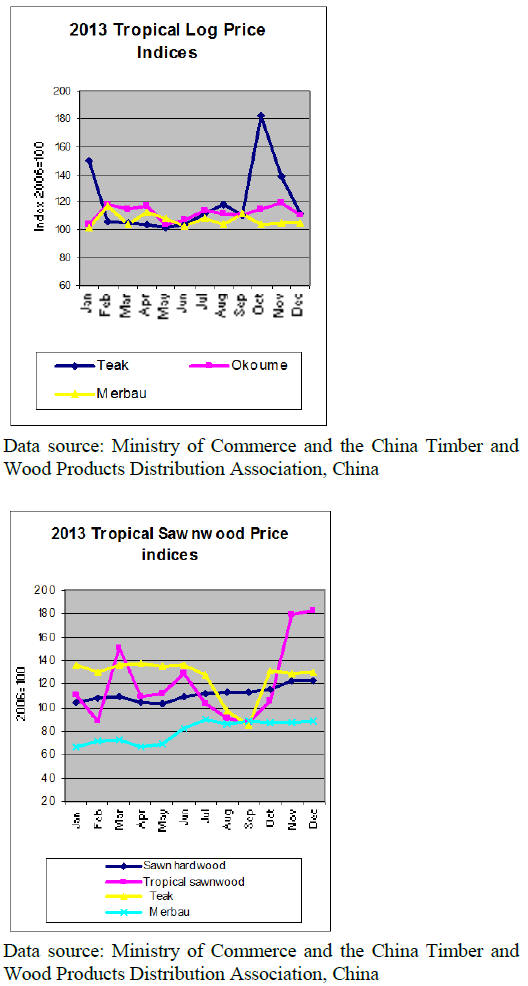
Eighth forest inventory published
China's State Forestry Administration (SFA) has briefed
the media on the latest resource inventory and forest
protection efforts by the SFA. Director, Zhao Shucong,
pointed out that a National Forest Resource Inventory
Report is produced every five years and that latest report
covers the period 2009 through to 2013.
The report states that China‟s forested area extends to 208
million hectares up from the 195 million hectares in 2008.
Forest stocking volumes are estimated at 15,137 million
cubic metres (13 721 million cubic metres in 2008). The
forest coverage increased to 21.63 percent of the country‟s
total land area from 20.36 percent in 2008.
Both forested area and stocking volume continued to
increase. China‟s forested area increased 13 million ha.
and stocking volume increased 1416 million cubic metres
from 2008.
The area of forest plantations has increased by 7.64
million ha. from 61.69 million ha in 2008 to 69.33 million
ha in 2013. The stocking volume increased 522 million
cubic metres from 1.961 cubic metres in 2008 to 2,483
million cubic metres in 2013.
China‟s national annual timber consumption was reported
as about 500 million cubic metres with around half being
imported. National timber consumption is forecast to rise
to 800 million cubic metres by 2020.
How to increase the domestic wood supply and reduce the
dependence on timber imports is one of the major
challenges in China. The SFA has a target of keeping
timber imports at no more than 60% of national
consumption.
To achieve this goal it is planned that 4 mil. ha. of
domestic plantations will be established annually to create
a strategic reserve. In addition overseas investment in
forestry will be expanded. At the moment China has more
than US$15 billion invested in foreign forestry projects
and has rented or purchased about 40 million ha. of
forested land in other countries.
China-Russia cooperation for a legal timber trade
China‟s log imports from Russia have fallen in recent
years because the Russian government imposed high
export tariffs on logs but sawnwood imports from Russia
increased dramatically from 2004 to 2013.
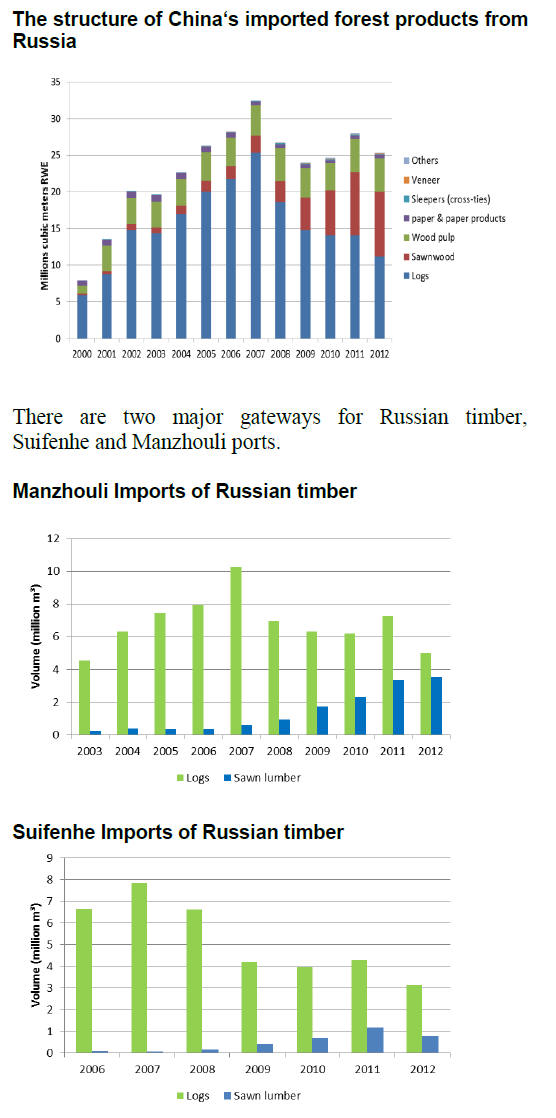 
The softwood species imported from Russia are mainly
Mongolian pine, white pine, Korean pine, and larch.
Around 80% of the imports from Russia are consumed in
domestic markets for construction, interior decoration and
furniture.
Most of imported hardwood species are ash, oak, linden
and birch which are used mainly for the manufacture of
flooring, furniture and plywood much of which is
exported.
Despite the thriving timber trade between Russia and
China there are some major challenges that must be
addressed.
Analysts in China have identified the following issues of
concern:
China‟s dependence on Russian imports creates
uncertainty as export rules may change without
notice.
There are no detailed forest resources data in
Russia
Russia‟s foreign labour regulations act to hold
down long-term investment by Chinese
enterprises.
The Russian Far-East is economically overdependent
on timber exports.
The current China-Russian forest industry is
predominantly of small scale enterprises.
Verification of the legality of the Russian timber
is an issue.
In response to the challenges identified above the Chinese
government has signalled its intention to undertake the
following actions:
Establish a government-led cooperation
framework to promote trade between the two
countries.
Facilitate „green‟ growth by improving forest
quality in the border between China and Russia.
Expand timber processing zones/business parks
in the bordering area.
Increase China-Russia cooperation on forestry
law enforcement.
Provide stronger guidance for Chinese enterprises
to regulate their forest management.
Establish a China-Russian Commercial Chamber
on Forestry
Specific suggestions for Chinese enterprises operating in
Russia and for Chinese timber importers have been drafted
by the Chinese authorities. The main suggestions for
enterprises regarding the legality of the timber are
summarized below:
 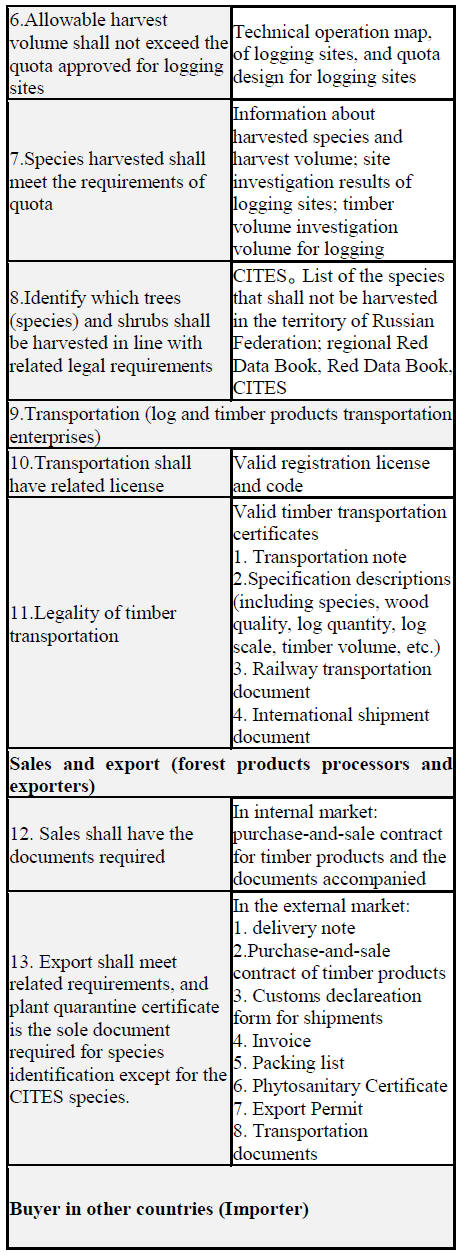

Promoting a legal and sustainable timber trade
In late February this year an international workshop
„Promoting Legal and Sustainable China-Russia Timber
Trade‟ was jointly hosted by the Institute of Forestry
Policy and Information within the Chinese Academy of
Forestry (CAF), the State Forestry Administration‟s
International Trade Research Center for Forest Products,
Forest Trends, the European Forestry Institute (EFI), the
World Wildlife Fund (WWF) and the Suifenhe municipal
government.
The aims of this workshop were to promote a legal and
sustainable China-Russia timber trade, to share
information, to promote policy dialogue and to identify
feasible solution for enterprises.
According to the conference, China‟s Timber Legality
Verification Standard was issued by China National Forest
Products Industry Association. The Research Institute of
Forestry Policy and Information, under Chinese Academy
of Forestry is developing the guideline on oversea timber
trade and investment.
Russian roundwood Act
It has been reported that an amendment to the Russian
Forestry Code (Federal Law of December 28, 2013N 415-
FZ) has been made.
See:
http://www.rg.ru/2013/12/30/drevesina-dok.html
This amendment changes the requirements for
measurement, marking, registration and the transport of
roundwood. The amendment aims to provide a system to
document and provide tracability for roundwood from the
harvest site, through transport and sale to the point of
processing or export.
If successful this system would be significant for
importers of Russian roundwood who wish to be assured
of the legality of their raw materials.
Chinese manufacturers are large importers of roundwood
and wood products from the Russia Far East where illegal
logging is of considerable concern so the latest
improvements proposed in documentation are very
welcome.
Improving the legality of the Russian forest sector and
increasing the ability to trace roundwood back to the forest
of origin and providing assurance of the legality will be an
important means for Chinese manufacturers to provide
overseas buyers with the required information and
documentation on legality.
|